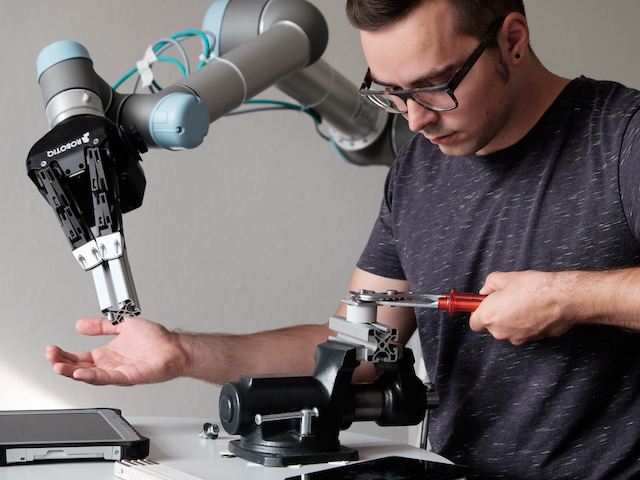
Exploring new frontiers in human-robot collaborations

Above: Methods developed in Ben Amor’s lab allow robot assistants to anticipate the actions of human co-workers and help whenever needed. Photo provided by ASU’s Interactive Robotics Lab.
Imagine an assembly robot that collaborates with a human to assemble a piece of IKEA furniture. The robot would need to analyze the movements of the human to avoid potentially hazardous collisions.
Heni Ben Amor is trying to help robots better understand and respond to human behavior. The assembly robot may learn that it must hand over a screwdriver whenever a human is stretching out an arm.
Ben Amor, an assistant professor computer science and engineering in Arizona State University’s Ira A. Fulton Schools of Engineering, is working to make advances in human-robot collaboration and on identifying the importance of such collaborations.
“I develop new methods that allow a robot to work in close proximity with human partners,” he said. “To ensure safe interaction, autonomous robots need to include movements and actions of human partners into their decision-making process.”
There is a widespread misconception that robots will replace humans in all workplaces, Ben Amor said. While it is true that robots can perform mundane, repetitive tasks better than humans, there are still many tasks at which humans are way better than robots.
He believes in a combination of robotic strength and speed on one side, and human decision-making, creativity and dexterity on the other side of a symbiotic relationship between robot and human.
“A fascinating aspect of working with robots is discovering how challenging even presumably simple tasks can be for a machine,” he said. “For humans, opening a fridge is not a particularly difficult thing to do. For robots however, this can be a daunting challenge.”
Even after having a human program all the steps involved, “it may actually take the robot more than five minutes to accomplish the task. It is therefore very inspiring to see how nature managed to find very elegant and versatile solutions to similarly difficult problems,” Ben Amor said.
“I am particularly intrigued by learning capabilities of biological systems,” he said. “Humans and animals often learn to adapt and change their behavior whenever faced with a new challenge.”
Human-robot collaboration has become an important aspect of many applications of robotic technologies, such as in the automotive industry.
There is a strong interest in bringing human and robot capabilities together. For many tasks, human skills remain important, but other tasks could best be accomplished by the strength and agility of robots. Deploying robots to help humans in physically demanding tasks could, for instance, lead to a significant reduction in work-related injuries.
Ben Amor is intrigued by machine learning involving robots. He wants to find out if robots can learn how to solve tasks on their own, by employing a human-like trial-and-error strategy to acquire new motor skills or imitating observed human behaviors and learning to program themselves based on what they observe.
“One idea that I am particularly fascinated by is a robot that reads a manual to learn to program itself,” he said.
He expands on the idea of a robot assembling IKEA furniture. All of the pieces of furniture come with a manual that is originally intended for humans. He hopes that in the future a robot could scan the manuals and extract the knowledge it needs to program itself to do the assembly.
“I think for the acceptance of robots in many application domains it is important to reduce the programming effort that is currently involved,” he said. “Robot learning can help eliminate this effort and thereby enable even laymen to train or program a new robot.”
One area Ben Amor is looking to investigate further is bi-manual grasping and manipulation by robots. Typically, robotic technologies employed in manufacturing operations use only one arm to perform various tasks. He wants to develop methods that give robots increased dexterity so they can match the ability of humans in using two hands and arms.
Media Contact
Erik Wirtanen, [email protected]
480-727-1957
Ira A. Fulton Schools of Engineering




































